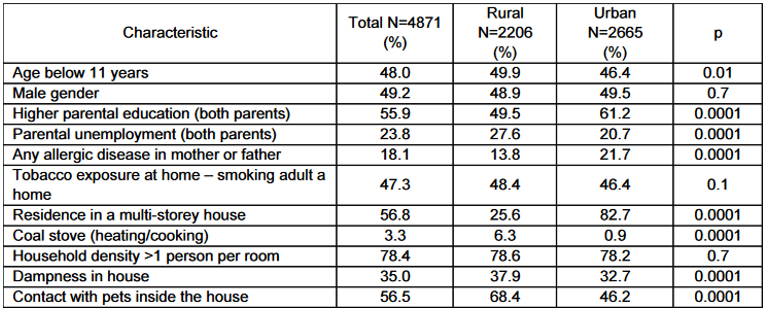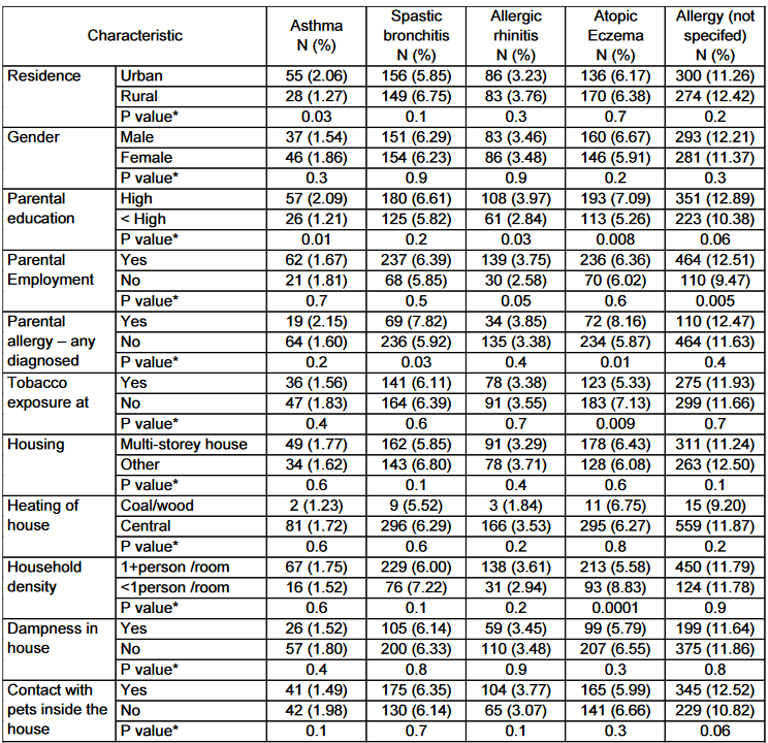Research Article | DOI: https://doi.org/WHRWB/RA/005
The Factors with Asthma and Allergic Diseases in Ukrainian Children Population
Abstract
Background: Asthma and other allergic diseases as influenced by environmental and familial factors might be targeted using preventive measures. These diseases are a matter of some urgency in Ukraine because of
the clinical, social and economic importance in childhood.
Objective: The aim of this study was to investigate the relationship between prevalence of asthma, spastic bronchitis, allergic rhinitis, atopic eczema, unspecified hypersensitization and some selected environmental and familial factors in a population sample of 6 to14-yrs old Western Ukraine schoolchildren.
Methods: The data set of the study was collected using a questionnaire-based survey, containing the data of 4871 urban and rural children age 6 to 14 years. Correlation of asthma and allergic disease with familial and environmental factors was examined by means of multivariate logistic regression.
Results: Increased risk of asthma (1.7 %) was associated with the urban residence (OR=1.8; p=0.04) and high parental education (OR=1.8; p=0.02); spastic bronchitis (6.2%) – with parental allergy (OR=1.3; p=0.03); atopic eczema (6.2 %) – with younger age (OR=1.3; p=0.03), high parental education (OR=1.3; p=0.03), parental allergy (OR=1.4; p=0.02), tobacco smoke at home (OR=0.7; p=0.01) and household density (OR=0.6; p=0.001);diagnosis of unspecified allergic sensitization (11.8 %) was related to high parental education (OR=1.2; p=0.03),parental employment (OR=0.8; p=0.02) and pets at home (OR=1.2; p=0.06).
Conclusions: This study identifies that lifeslyle and building factors are associated with an altered prevalence of common childhood allergic diseases. Prevention may need to address the minimization of potential risk-factors.
Introduction
Prevalence of asthma and allergies among children has become an increasing problem during the last few decades. Asthma has become the most common chronic disease among children and is one of the major causes of hospitalization among those younger than 15 years of age. As more people become sensitized to allergens, allergic diseasesmay increase in Europe in the coming years [1].Previous ISAAC studies revealed a relatively lowprevalence of allergic diseases specifically in EasternEurope. While the results of the studies from differentareas in Eastern Europe have been reported, lessis known about the current epidemiology of childhood allergic diseases in different areas of Ukraine [2, 3].
With the prevalence of childhood asthma and allergic diseases increasing worldwide over the past decades, it is widely accepted that environmental factors, in addition to genetics, are closely related to allergic diseases [4, 5]. The role of environmental factors in relation to asthma and allergy increased through the 1990s.
There has been widespread public concern that changing patterns of outdoor air pollution underlie the rising burden of asthma, but the professionals are not so sure about such correlations. The indoor environment, in which people spend most of their time, has received less attention [6, 7].
The aims of this study was firstly, to quantify the prevalence of asthma, spastic bronchitis, allergicrhinitis, atopic eczema, unspecified hypersen-sitization in schoolchildren in Ternopil and Ternopil region, and secondly, to evaluate associations between children's asthma and allergic diseases from one side and housing and familial charac- teristics from another.
Methods
We used questionnaire which was based on the ISAAC symptom questionnaire in Ukrainian language. The questionnaires were answered by parents or guardians of children, aged 6 to 14 years old from Ternopil and surrounding rural area. Issues and factors affecting the prevalence of physician-diagnosed asthma, spastic bronchitis, allergic rhinitis, atopic eczema, and unspecified hypersensitization were included in the list of allergic diseases. The study protocol was approved by the local ethics committee at the Ternopil State Medical University Independent variables of interest were based on questionnaire self-report. Subgroups of subjects defined by place of residence (urban/rural), gender (male/female), age group (<10>10 years old), parental education (less than high school/high school or above), parental employment (both unemployed/otherwise), any diagnosed parental allergy (at least one parent: yes/no), tobacco exposure at home – smoking adult at home (yes/no), housing (multi-storey house/ otherwise), heating of the house (coal or wood stove/otherwise), household density – defined as the ratio of persons living in the house to rooms in the house (1 person per room/otherwise), dampness in house defined as moisture stains or signs of mold on the inner surfaces in the house (yes/no), contact with pets inside the house (yes/no). Statistical analysis was performed by using Statistica 7.1 software. Descriptive analyses were used to examine the prevalence of each outcome with the personal and environmental characteristics of the study population. Statistical significance was assessed using chi 2 test. Multivariable logistic regression analyses with each outcome were used to examine the association with the personal and environmental characteristics and to account for potential confounding. For these analyses, outcomes were the diseases or symptoms of interest. The strength of association was based on the Odds ratio (OR) and 95 % confidence intervals (CI).
Results
Analysis of 4871 completed questionnaires has found the following results: study population was 50.8 ?males and 49.2 % males. 54.7 % of children lived in an urban area, 47.3 % – in rural. Groups of children living in urban and rural areas were similar (p<0>
Bronchial asthma prevailed in children from urban areas or those with a higher parental education. A higher prevalence of spastic bronchitis was found among those with a parental history of allergy. A higher prevalence of allergic rhinitis was also found among those in an urban area compared to a rural area. There were no statistically significant differences between categories of the characteristics considered for atopic eczema.
As results from logistic regression analysis, we found that an increased risk of asthma was associated with urban residence (p=0.04) and high parental education (p=0.02). Spastic bronchitis was associated with parental allergy (p=0.03). Atopic eczema had statistically significant associations with younger age (p=0.03), high parental education (p=0.03), parental allergy (p=0.02), tobacco smoke at home (p=0.02) and household crowding (p=0.0007). Diagnosis of unspecified sensitization was related to high parental education (p=0.03) and parental employment (p=0.02) (Table 3).


Conclusions:
This cross-sectional examination suggests that environmental and family risk factors are associated with prevalence of asthma, spastic bronchitis, atopic eczema and unspecified sensitization in 6 to 14-yrs-old schoolchildren in Ternopil. The determination of potentially preventable environmental and family factors affecting risk of allergic disease is important, considering the apparent world-wide increases in the prevalence of childhood allergic disease. This study identifies lifestyle, building factors which are associated with an altered prevalence of common childhood allergic disease. Prevention may need toaddress the minimization of potential risk-factors.
Acknowledgments :
The authors would like to thank those individuals who participated in this data collection. The Ministry of Foreign Affairs (Poland) – Polish Aid 2011: “Polish Assistance to the Prevention of Large Public Impact Lung Diseases in Belarus and Ukraine” provided financial support for the project under the grant [249/ PR/2011]. The authors thank the children and parents who participated in this study.
References
-
The International Study of Asthma and Allergies in Childhood Steering Committee: Worldwide variation in prevalence of symptoms of asthma, allergic rhino- conjunctivitis, and atopic eczema: ISAAC. Lancet 1998; 351(9111): 1225–1232.
View at Publisher | View at Google Scholar -
Brozek M, Zejda JE, Kowalska M, Gebus M, Kepa K, Igielski M. Opposite trends of allergic disorders and respiratory symptoms in children over a period of large-scale ambient air pollution decline. Pol J Environ Stud 2010; 19(6): 1133–1138.
View at Publisher | View at Google Scholar -
The prevalence rates of symptoms of asthma and allergic rhinoconjunctivitis in children aged 6–7 years and 13–14 years Fact Sheet No. 3.1 may 2007, Code: RPG3 Air E1.
View at Publisher | View at Google Scholar -
Wang TT, Zhao ZH, Yao H et al. Housing characteristics and indoor environment in relation to children’s asthma, allergic diseases and pneumonia in Urumqi, China. Chinese Science Bulletin 2013; 58(34): 4237–4244.
View at Publisher | View at Google Scholar -
Balo BB, Makra L, Matyasovszky I, Csepe Z. Association of sociodemographic and environmental factors with allergic rhinitis and asthma. Acta climatologica et chorologica 2012; 46: 33–49.
View at Publisher | View at Google Scholar -
Asher MI, Stewart AW, Mallol J, Montefort S, Lai CKW, At-Khaled N, Odhiambo J, The ISAAC Phase One Study Group. Which population level environmental factors are associated with asthma, rhinoconjunctivitis and eczema? Review of the ecological analyses of ISAAC Phase One. Respir Res 2010, 11:8.
View at Publisher | View at Google Scholar -
Strachan DP. The role of environmental factors in asthma. British Medical Bulletin 2000; 56(4): 865–882.
View at Publisher | View at Google Scholar -
Leonardi GS, Houthuijs D, Nikiforov B, Volf J, Rudnai P, Zejda J, Gurzau E, Fabianova E, Fletcher T, Brunekreef B. Respiratory symptoms, bronchitis and asthma in children of Central and Eastern Europe. Eur Respir J 2002; 20(4): 890–898.
View at Publisher | View at Google Scholar -
Fedortsiv O, Brozek GM, Luchyshyn N, Kubey I, Lawson JA, Rennie DC, Zejda JE. Prevalence of child- hood asthma, rhinitis, and eczema in the Ternopil region of Ukraine – results of BUPAS study. Adv Med Sci 2012; 57(2): 282-289.
View at Publisher | View at Google Scholar






